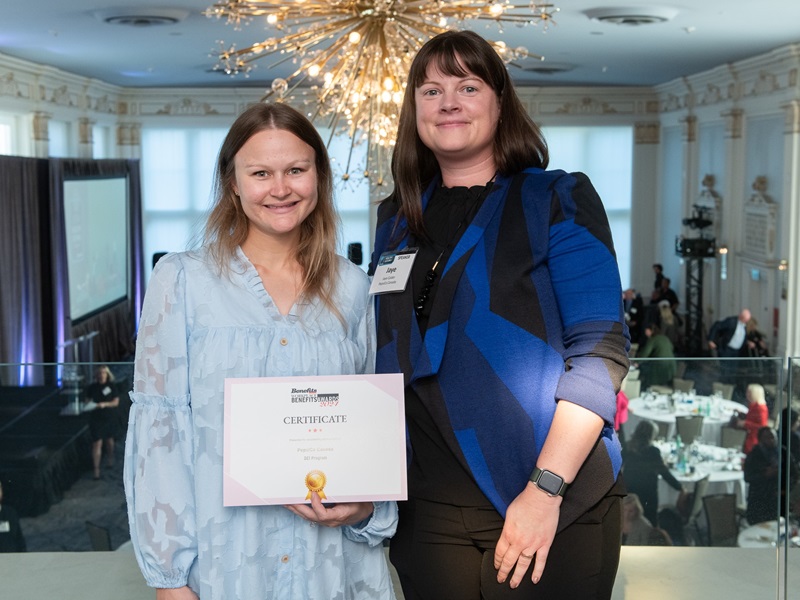
PepsiCo Canada’s 2024 Workplace Benefits Awards win demonstrates how weaving diversity, equity and inclusion into strategic business practices can foster employee mental health and wellness.
The food and beverage company’s inclusive end-to-end business transformation strategy made it this year’s winner in the DEI Program category. “It’s so fantastic that all of our hard work has been recognized,” says Jaye Calder (pictured right), PepsiCo Canada’s manager of pension, benefits and wellness. “I think that is so important. I know it feels like we’re in our own little bubble when we’re doing the work everyday and so [this win] is nice.”
This year, the organization introduced several new family-building benefits and enhanced some of its existing offerings. This included adding Carrot Fertility, a fertility care and family-building support platform that provides personalized support for people exploring their fertility health, pursuing parenthood or experiencing menopause or low testosterone; increasing both the standard and enhanced maximums of its fertility drugs and treatment coverage to $10,000 (standard) and $15,000 (enhanced), both up from $5,000; raising the coverage of its surrogacy and adoption benefits to $10,000 (standard) and $15,000 (enhanced) from $4,000; and adding coverage for breast pumps up to a lifetime maximum of $500.
Read: 42% of global employees say lack of employer-provided fertility benefits is a ‘deal breaker:’ survey
PepsiCo Canada’s end-to-end strategy is fulsome, weaving inclusion into its benefits, attraction and retention and training programs. Indeed, each of its six employee resource groups are supported by an executive sponsor and includes a member of the total rewards team, which Calder says has been extremely beneficial. “Being able to weave total rewards into all of the ERG conversations that we’re having has been so important.”
For instance, as a member of the EQUAL ERG, she was able to hear from its LGBTQ2S+ group members on their journeys to building their families. This presented an opportunity for her to learn how the organization could leverage its new Carrot Fertility benefits to help support these employees on their journeys.
Similarly, Jess Harmgardt (pictured left), a total rewards associate at PepsiCo Canada, who is a member of the Women’s Inclusion Network and the EnAble group that supports neurodivergent employees, says the total rewards team is able to really listen to what’s important to employees and then act on the feedback. “That’s the special part — that we were able to achieve things they wanted and needed.”
Read: Back to basics on employee resource groups
In addition, PepsiCo Canada enhanced many of its well-being benefits, including raising its physiotherapy coverage to $1,000 (standard) and $1,500 (enhanced), up from $600 and $1,000, respectively. It also increased its mental-health coverage to $2,000 (standard) and $3,000 (enhanced), up from $800 and $1,000, respectively. It has also added gender affirmation coverage of $10,000 (standard) and $15,000 (enhanced), as well as implementing a $3,000 annual maximum for weight-management drugs.
Within its attraction and retention strategy, the organization ensures it’s providing equitable access to development opportunities, promotions and leadership roles by embedding DEI goals and behaviours into performance reviews and leadership evaluations. It also developed a unique program designed to equip women with the tools they need to elevate their business impact and achieve career fulfillment. By the end of 2023, the company achieved 45 per cent women in management roles, globally.
As well, PepsiCo Canada has created forums where employees can meet to discuss DEI issues and experiences and developed numerous DEI training programs, including unconscious bias training, cultural competence, inclusive leadership, psychological safety, mental-health stigma and emotional intelligence topics. Its DEI communications engages employees through town halls, digital signage, targeted emails, leadership cascade, frontline huddles, live learning sessions and through its online resource centre.
To ensure its strategy is meeting its goals, the organization conducts health surveys to collect and analyze data on demographics, hiring, promotions and turnover to identify gaps and measure progress. Its DEI councils and committees monitor progress and report on outcomes with employees and stakeholders to maintain transparency and build trust.
Read: How employers are using data to integrate DEI into their benefits plans
“We try our best to produce high-quality offerings, plans and programs so we track things like click rates on our communications,” says Harmgardt. “[We use] the metrics and statistics to then build better programs, [which is] something we’re excited for. We acted and delivered, but now we can make [those programs] even better because we can see exactly what [employees are] honing in on in our programs and plans.”
“The biggest accomplishment is employees being happy with the program first and foremost,” adds Calder. “Any time we go live and have high utilization that is our No. 1 [accolade]. We all get super excited when our employees are excited about the programs we offer. But this win [shows] . . . we’re on the right track.”
